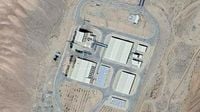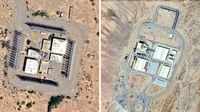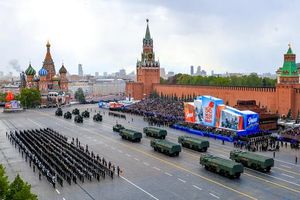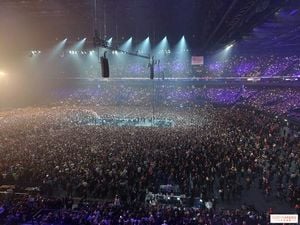In a troubling development for international relations, Iranian dissidents have revealed satellite imagery allegedly showing a previously undisclosed nuclear weapons facility, located in Semnan Province, Iran. The National Council of Resistance of Iran (NCRI) has identified this site, code-named the "Rainbow Site," as a covert operation disguised as a chemical production plant known as Diba Energy Siba. This facility, which spans approximately 2,500 acres near Ivanaki, has reportedly been active since 2013.
The NCRI claims the site specializes in extracting tritium, a radioactive hydrogen isotope that enhances the explosive yield of nuclear warheads. Unlike enriched uranium, tritium has no civilian or commercial applications, raising significant doubts about Tehran's long-standing assertions that its nuclear program is strictly for peaceful purposes. Furthermore, these allegations suggest that the facility may be involved in efforts to develop a hydrogen bomb, although direct evidence of warhead production has yet to be confirmed.
In response to these allegations, Iranian Foreign Minister Seyed Abbas Araghchi dismissed the report as a political distraction aimed at undermining upcoming nuclear talks. “Like clockwork, more Very Scary Satellite Images are being circulated as Iran-U.S. indirect nuclear talks are set to resume,” Araghchi stated. Iran's Mission to the United Nations has also rejected the claims made by the NCRI and the Mojahedin-e-Khalq Organization (MKO), labeling them as fabrications and accusing the groups of collaborating with foreign intelligence to spread misinformation.
The timing of this revelation adds complexity to ongoing nuclear negotiations between the Trump administration and Tehran. Since talks began in February 2025, they have progressed through multiple rounds, with the next session reportedly planned in Oman. However, core disagreements remain, particularly regarding Iran’s insistence on retaining uranium enrichment capabilities and the U.S. push to include restrictions on Iran's missile program and proxy forces. Despite some consensus on International Atomic Energy Agency (IAEA) inspection access and verification steps, discussions have stalled, with Iranian officials claiming that the U.S. introduced new demands late in the process, contributing to heightened tensions.
Israeli Prime Minister Benjamin Netanyahu has urged Iran to dismantle its nuclear program, drawing parallels to Libya’s 2003 deal to abandon its nuclear ambitions in exchange for sanctions relief and normalized ties with the West. Critics of this comparison highlight that the eventual fate of Libyan leader Moammar Gadhafi—who was overthrown and killed by rebels—serves as a cautionary tale for Iranian officials, who often cite such events as reasons to maintain their nuclear capabilities.
While President Trump has emphasized the need for a "strong, verified deal" with Iran, he has also indicated that military action could be considered if diplomacy fails. Although he has publicly pushed for the complete dismantlement of Iran's nuclear program, Special Envoy Steve Witkoff and Vice President JD Vance have focused on securing transparency and strict limits. Speaking at the Munich Leaders Conference on May 7, 2025, Vance stated that the U.S. could support a civilian nuclear program in Iran, provided it completely rules out any path to weaponization.
According to reports, the Rainbow Site is not the only covert facility Iran has established since the exposure of its previous nuclear weapons program, the Amad Plan, in 2003. The Ivanaki facility, which operates under the guise of a chemical factory, has been covertly managed by Iran’s Organisation of Defensive Innovation and Research (SPND). The site reportedly comprises three factory-like units, a command headquarters, and a high-security checkpoint, all heavily guarded by elite units of Iran’s military. The strategic location, just 55 kilometers southeast of Tehran, underscores its importance to Iran's nuclear ambitions.
The Iranian opposition claims that the regime has set up at least five shell companies to disguise the advanced nuclear weapons site as a legitimate industry, successfully evading international scrutiny and sanctions. Despite Iran's assertions that its nuclear program is intended for peaceful purposes, the ongoing tensions and shifting power dynamics in the Middle East have led to increased pressure on Iranian Supreme Leader Ayatollah Khamenei to lift the ban on developing nuclear weapons. Reports indicate that top commanders of Iran's Islamic Revolutionary Guard Corps (IRGC) have urged Khamenei to withdraw his fatwa prohibiting the use of nuclear capabilities for weapon development.
As the situation unfolds, the implications for regional security remain significant. The discovery of the Rainbow Site has not only heightened concerns among Israel and the United States but has also raised alarms among other nations monitoring Iran's nuclear activities. The potential for Iran to develop advanced nuclear weaponry poses a serious threat to stability in the region, and the international community watches closely as negotiations continue.
The ongoing dialogue between the U.S. and Iran is fraught with challenges, and the revelations surrounding the Rainbow Site add another layer of complexity to the already intricate negotiations. As both sides prepare for future talks, the stakes have never been higher, and the outcome could have far-reaching consequences for global security.





